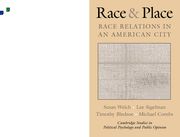Book contents
- Frontmatter
- Contents
- List of Figures
- List of Tables
- Preface
- 1 Introduction
- 2 Race Relations in Detroit, 1968–1992
- 3 Black–White Social Interaction
- 4 Perceptions of Racial Discrimination
- 5 Black Racial Solidarity
- 6 White Racial Prejudice
- 7 Opinions on Urban Issues: The Schools and the Police
- 8 Conclusions
- Appendix A The Detroit Surveys
- Appendix B Detroit Survey Items and Measures
- References
- Author Index
- Subject Index
- Miscellaneous Endmatter
8 - Conclusions
Published online by Cambridge University Press: 05 June 2012
- Frontmatter
- Contents
- List of Figures
- List of Tables
- Preface
- 1 Introduction
- 2 Race Relations in Detroit, 1968–1992
- 3 Black–White Social Interaction
- 4 Perceptions of Racial Discrimination
- 5 Black Racial Solidarity
- 6 White Racial Prejudice
- 7 Opinions on Urban Issues: The Schools and the Police
- 8 Conclusions
- Appendix A The Detroit Surveys
- Appendix B Detroit Survey Items and Measures
- References
- Author Index
- Subject Index
- Miscellaneous Endmatter
Summary
We began this book by asking whether the decline in residential segregation in major metropolitan areas affects the way blacks and whites think about themselves and each other. We begin this concluding chapter by stating that it does matter. Whites' attitudes about blacks and blacks' attitudes about whites are indeed affected by where blacks and whites live in relationship to each other. The views of both blacks and whites about urban public policies are also strongly shaped by where they live.
Of course, residential segregation shapes much about urban life, including the quality of schools that children attend, the crime rates and the social pathology of the neighborhood in which families live, and the availability of opportunities for job seekers. On the whole, life chances are strongly influenced by the neighborhood in which one resides, so it is not surprising that where one lives affects attitudes too. Directly and indirectly, residential patterns have the potential to influence many key attitudes and behaviors, including those about race, opportunity, politics, and policy.
The influence does not run exclusively in one direction, however. People choose their neighborhoods, and some do so to escape living with people of another race. However, to acknowledge this important reality is not to deny the significance of the findings that neighborhoods influence individuals' choice of friends, casual contacts, views about public policies, and many other attributes relevant to interracial relationships.
- Type
- Chapter
- Information
- Race and PlaceRace Relations in an American City, pp. 156 - 170Publisher: Cambridge University PressPrint publication year: 2001



